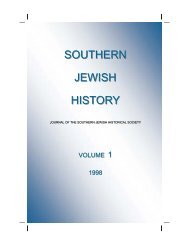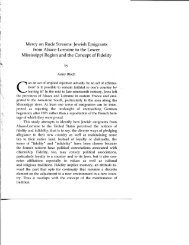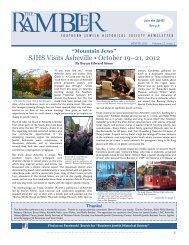A Shtetl Grew in Bessemer - Southern Jewish Historical Society
A Shtetl Grew in Bessemer - Southern Jewish Historical Society
A Shtetl Grew in Bessemer - Southern Jewish Historical Society
Create successful ePaper yourself
Turn your PDF publications into a flip-book with our unique Google optimized e-Paper software.
BARR/A SHTETL GREW IN BESSEMER 7<br />
between Meridian and Chattanooga, Mobile and Nashville, Savannah<br />
and Memphis, and New Orleans and Louisville. Even <strong>in</strong><br />
1888 its rail l<strong>in</strong>es led “directly to Texas via Vicksburg and<br />
Shreveport and via New Orleans; to Gulf ports, directly to New<br />
Orleans, to Mobile and to Pensacola; to all of the Atlantic ports<br />
and to the North, Northwest and West.” 26 More specifically,<br />
<strong>Bessemer</strong>’s proximity to Birm<strong>in</strong>gham, which by the turn of the<br />
century boasted three <strong>Jewish</strong> congregations, and to Tuscaloosa,<br />
home of the University of Alabama, made it attractive to the early<br />
<strong>Jewish</strong> pioneers. While economic reasons brought Jews to<br />
<strong>Bessemer</strong>, religion and social/cultural cohesion contributed to<br />
their cont<strong>in</strong>uity.<br />
F<strong>in</strong>ally, as many historians have noted, 27 <strong>Jewish</strong> immigrants,<br />
particularly from eastern Europe, were adept at fill<strong>in</strong>g the needs<br />
of a new town. Many were perform<strong>in</strong>g similar roles to those they<br />
performed <strong>in</strong> Russia or Poland. But while they were marg<strong>in</strong>alized<br />
<strong>in</strong> the old country because their occupations were peripheral to<br />
the central agricultural economies, <strong>in</strong> small towns like <strong>Bessemer</strong><br />
they fulfilled their own desires by mak<strong>in</strong>g a comfortable liv<strong>in</strong>g for<br />
themselves and their children. Concurrently, they met the needs<br />
of the then-ma<strong>in</strong>ly-m<strong>in</strong><strong>in</strong>g community by their will<strong>in</strong>gness and<br />
ability to launch complementary bus<strong>in</strong>esses, such as dry goods<br />
and retail cloth<strong>in</strong>g stores and even saloons. Because of their<br />
adaptability and will<strong>in</strong>gness to participate <strong>in</strong> civic affairs, they<br />
achieved a great degree of acceptance as bus<strong>in</strong>ess leaders and thus<br />
even their <strong>Jewish</strong>ness was tolerated, if not theologically, at least<br />
practically.<br />
The earliest group of Jews to settle <strong>in</strong> <strong>Bessemer</strong> <strong>in</strong>cluded<br />
many who contributed to the city’s growth. Samuel Ste<strong>in</strong> was a<br />
“bright particular star” from “<strong>Bessemer</strong>’s earliest dawn.” Accord<strong>in</strong>g<br />
to The <strong>Bessemer</strong> Weekly, Ste<strong>in</strong> was “among the first of our<br />
young bus<strong>in</strong>essmen to recognize the grand possibilities of the<br />
Marvel City and to cast his lot <strong>in</strong> with her.” An Alabama native,<br />
Ste<strong>in</strong> founded the North Calera Land Company <strong>in</strong> 1886 and made<br />
a fortune from it. He moved to <strong>Bessemer</strong> <strong>in</strong> August 1887, where<br />
he “laid the foundation of his career,” and then apparently established<br />
a new occupation, for soon “the famous query ‘Who’s Your







